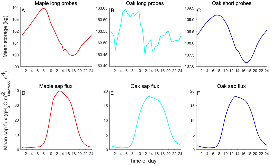Observations of stem water storage in trees of opposing hydraulic strategies
- The Ohio State Univ., Columbus, OH (United States). Department of Civil, Environmental, and Geodetic Engineering
- Decagon Devices, Pullman, WA (United States)
- The Ohio State Univ., Columbus, OH (United States). Department of Chemistry and Biochemistry
- Univ. of Michigan, Pellston, MI (United States). Biological Station
Hydraulic capacitance and water storage form a critical buffer against cavitation and loss of conductivity within the xylem system. Withdrawal from water storage in leaves, branches, stems, and roots significantly impacts sap flow, stomatal conductance, and transpiration. Storage quantities differ based on soil water availability, tree size, wood anatomy and density, drought tolerance, and hydraulic strategy (anisohydric or isohydric). However, the majority of studies focus on the measurement of storage in conifers or tropical tree species. We demonstrate a novel methodology using frequency domain reflectometry (FDR) to make continuous, direct measurements of wood water content in two hardwood species in a forest in Michigan. We present results of a two month study comparing the water storage dynamics between a mature red oak and red maple, two species with differing wood densities, hydraulic architecture, and hydraulic strategy. We also include results pertaining to the use of different probe lengths to sample water content only within the active sapwood and over the entire conductive sapwood and the outer portion of heartwood in red oak. Both species studied exhibited diurnal cycles of storage that aligned well with the dynamics of sap flux. Red maple, a diffuse porous, relatively isohydric species showed a strong dependence on stored water during both wet and dry periods. Red oak, a ring porous relatively anisohydric species, was less reliant on storage, and did not demonstrate a dependence on soil water potential. Comparison between long and short FDR probes in the oak revealed that oaks may utilize water stored in the innermost layers of the xylem when soil moisture conditions are limiting. We found the FDR probes to be a reliable, functional means for continuous automated measurement of wood water content in hardwoods at a fast time scale. Application of FDR technology for the measurement of tree water storage will benefit forest ecologists as well as the modeling community as we improve our understanding and simulations of plant hydrodynamic processes on a large scale.
- Research Organization:
- Rutgers Univ., New Brunswick, NJ (United States); Rutgers Univ., Newark, NJ (United States)
- Sponsoring Organization:
- USDOE Office of Science (SC), Biological and Environmental Research (BER); National Science Foundation (NSF)
- Grant/Contract Number:
- SC0007041
- OSTI ID:
- 1454703
- Alternate ID(s):
- OSTI ID: 1418641
- Journal Information:
- Ecosphere, Vol. 6, Issue 9; ISSN 2150-8925
- Publisher:
- Ecological Society of AmericaCopyright Statement
- Country of Publication:
- United States
- Language:
- English
Web of Science
Similar Records
Contrasting strategies of hydraulic control in two codominant temperate tree species
Species-specific transpiration responses to intermediate disturbance in a northern hardwood forest: Transpiration response to disturbance




